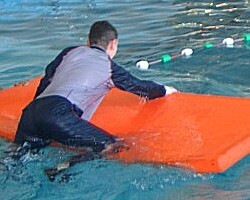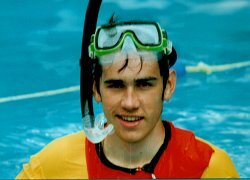Swim ABC - Dutch Swimming Lessons
The Swim ABC (Zwem ABC) teaches essential survival skills as an exciting fun sport. Survival Swimming in the Netherlands is an essential part of water safety education.
From age four kids learn in three stages how to swim and survive accidents. All these training programmes are very popular because they are great fun. From the very first swimming lesson attention is paid to safety and survival. This is done by trial and error, jumping into the water and climbing out.
Afterwards they learn the swimming strokes. In addition to they will continue to pay close attention to all kinds of exercises in deep water, such as different ways of going into the water, swim underwater, climbing and scrambling onto a raft or onto the poolside, and go to the bottom.
No matter whether it is a river or swimming lake, bathing in clear waters or entering ice areas, it all requires special skills. The participants learn to know their limits, as well as to take care of themselves and others so as not to get into dangerous situations.
Swimming Games
Many exercises are offered as part of a game, because that's the best way to learn.
Don't think that they are just playing in the water.
Each game has a purpose.
Swim ABC Objectives
The Swim ABC teaching method has already a long and successful tradition in the Netherlands. In a watery country it is a must that everyone can swim and can also help in exceptional situations.
That is why learning the Swim ABC swimming skills is of great importance. The goals are swimming skills, swimming safety and, of course, fun in the water. Ongoing training makes survival swimming an exciting fun sport.
Long Waiting Times for Lessons
The wet element has a magical attraction on children. For most there is no greater fun than to splash in the water and to romp with friends or "test" the ice surfaces in the winter.
For parents, it is a reassuring feeling to know that their children are able to act well even in dangerous situations. Schools, swimming pools and parents have realized this, so it is not surprising that there are long waiting times to participate in such a course.
Parents rescue Kids, Kids rescue Parents
We put a strong emphasis on parents joining their kids and teens in this course.
When parents can rescue their kids then you have good safety in the family.
When kids learn to rescue their parents, they are set for life,
enjoying fun in the water safely.
Teachers Create Adventure Variations
In a lifeguarded pool the teachers go into the water with the class. It gives participants confidence when they show all swimming exercises first for the class to copy.
For ongoing training they can adapt the survival swimming lessons with an adventure theme. Teachers and students wear the relevant clothes for the adventure to make it more fun and interesting.
A "Jungle Trek" in rain ponchos teaches wading skills, safe water entry and exit. "Winter Swimming" lessons in winter clothes simulate an ice rescue with floating mats.

Winter swimming

Safety divers keep an eye on the swimmers underwater.
Safety Divers
Lifeguards can act as safety divers by keeping an underwater eye on the swimming lessons.
We call them the "Safety Sharks".
They move around the pool slowly,
but act fast if a swimmer gets in difficulty.
Reader Comment: Swim Training Gets Tough
by Fietje from Amsterdam, NetherlandsFrom 7th grade the swimming lessons in my boarding school got fairly tough, with survival swimming, rescues, and strength building. I enjoyed that more than swimming up and down.
We started with kick-boxing in the pool, initially in swimwear, until we learned the skill. This was easy. Then we practiced in PE kit which took a bit more effort but was more interesting. Finally we did it fully clothed, quite hard at first, but I soon got good at it.
Now we have to swim in clothes most of the time which is tough but good fun. We're told to vary the clothes a lot, to get many different experiences. I've worn most of my sportswear in the pool. Swimming in PE kit is easy. We do that at the beginning of each lesson for endurance swimming.
Halfway through each lesson we get fully clothed for resistance swimming.
I like tracksuits best, but jeans and hoodie, joggings suits, or rainwear are fun too.
We have two swimming lessons a week, plus a pool play session most afternoons.
Luckily I have many clothes to swim in or they would never get dry.